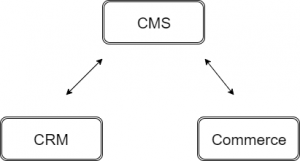Everybody knows that businesses run on the 3 C’s: Contact Relationship Management, Content Management Systems, and Commerce; however, most would argue that this is a pyramid where CRM represents your customers, they access the website, and they purchase products:

Successful businesses see this as a triangle, with CRM representing all your contacts, CMS representing all your content, and commerce representing all the things you purchase and sell.

Contact Relationship Management for all Your Contacts
With the popularity of Dynamics CRM and Salesforce, businesses are aware of their CRM needs with respect to their customers, and many tie their customers to employees in the form of sales representatives. For online experiences, they provide an e-commerce store for people to purchase. If they own a physical store, they have a client track for those customers as well. But the contact relationship is larger than just your customer and sales reps. You have relationships between employees and suppliers and employees and other employees. Most of the time these relationships are done in a silo.
The commerce package takes care of relationships of products and suppliers and products and customers. The CRM takes care of customers and sales reps. Successful businesses have an integration between their CRM and commerce systems that allow the sales reps to see purchases or abandoned purchase generated from their commerce system. Now if you are running low on something, the commerce system will know who the supplier is for that product they may even know who to contact if that supplier is unresponsive with product within the time you need to receive it. Success is to know the alternative contacts and alternative suppliers to reach out to regarding delivery of product.
The important takeaway here is that there is a strong relationship between all your contacts and all your purchase transactions both online and offline.
Ensuring Your Contacts have Access to the Right Content
The idea of relevant content for website visitors has been a much talked about topic for the past decade with the importance of marketing automation, personalization, a+b testing, etc. However, it has been in the past couple years that customers have been demanding such an experience and if they do not receive it they go elsewhere to find it. A marketing team sees their content buckets: their physical brochures and their website content. Successful businesses see that content refers to all the content in their organization together. You have customer-marketing materials in the form of printable brochures, website content, intranet content for employees and content provided by your various partners and suppliers. Managing all this content and ensuring there is proper integrations and organization of this content is key. Tying your eCMS like SharePoint to your Web CMS is very important, as is tying your Print and Web Content together.
The important takeaway here is that there is a strong relationship between all your content and all your contacts.
Leveraging Your Content at Time of Purchase and Adjusting your Content Based on Purchase
The idea of referring other products to customers when they purchase has been something Amazon and other stores have been doing for a while now. You buy this, and they up-sell you that. However, this is generally in your commerce engine alone. More recently there has been the relationship between online and offline commerce such that someone in store would know you bought a given product and then could recommend the accessories in store or vice versa. It is a more recent idea that you adjust the content on your website based on product purchases. However, customers are already starting to expect this and if you are not doing it they notice. A prime example is ad serving. You visit a website and start eyeing a product say a trip to Las Vegas. Now every time you hit another page or website you see that trip in your ads. They target you but what if you already booked that trip. Well that means your ad placement is a waste but not only that, it is an annoyance to your customer. Now if from your commerce engine you could update the ad rules such that for that person you show tour packages in Las Vegas, then the ad is no longer wasted. This is but a single example of the many possible relationships between commerce and CMS.
The key takeaway here is that a strong relationship between commerce and CMS provides a better experience for a customer and can increase the likelihood of up-sell.
The 3 C’s Triangle
A tightly integrated triangle between CRM, CMS, and commerce is very important and is expected by customers. Adding the missing link could mean additional revenue and happier customers overall.
Look for the second article in the series where we introduce the 4th C and how it assists each part of the triangle to produce more relevance.
